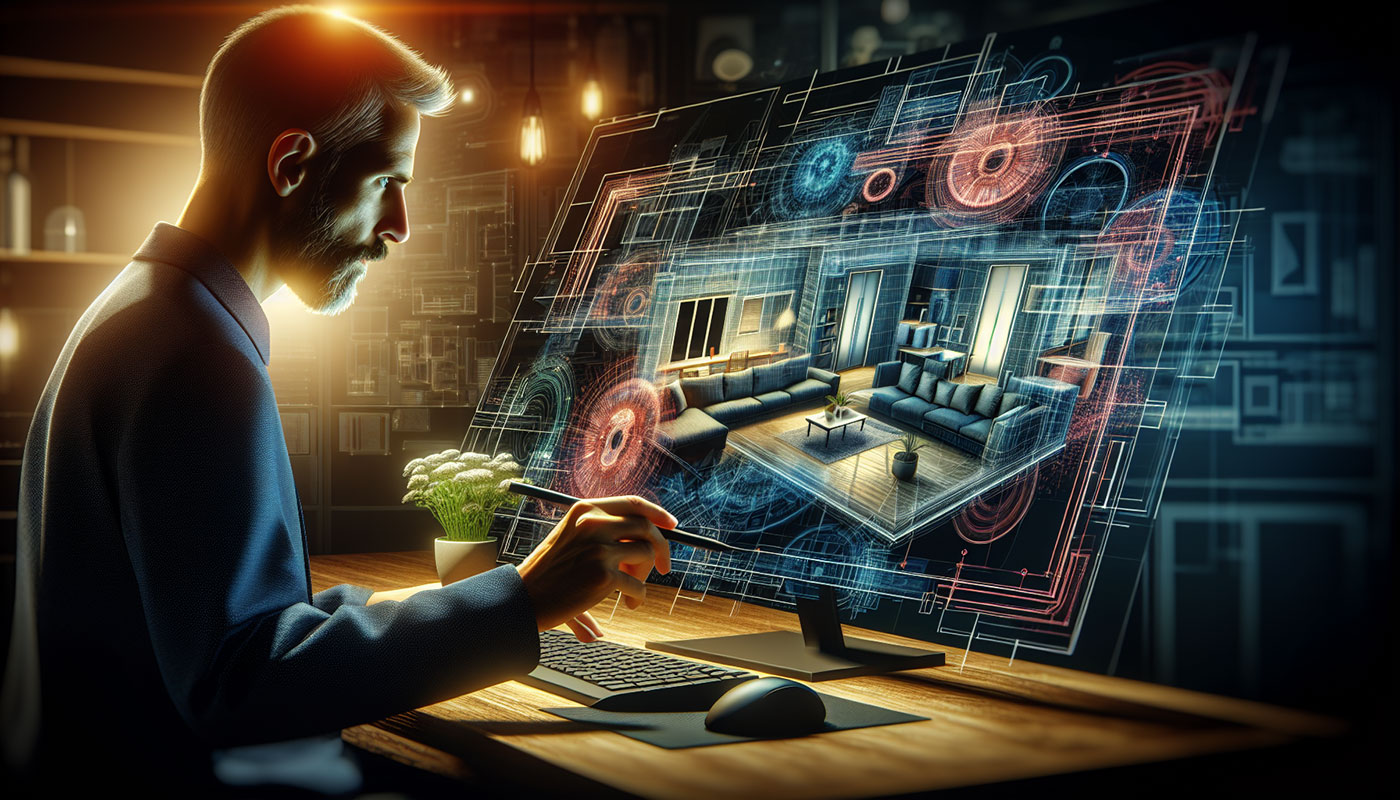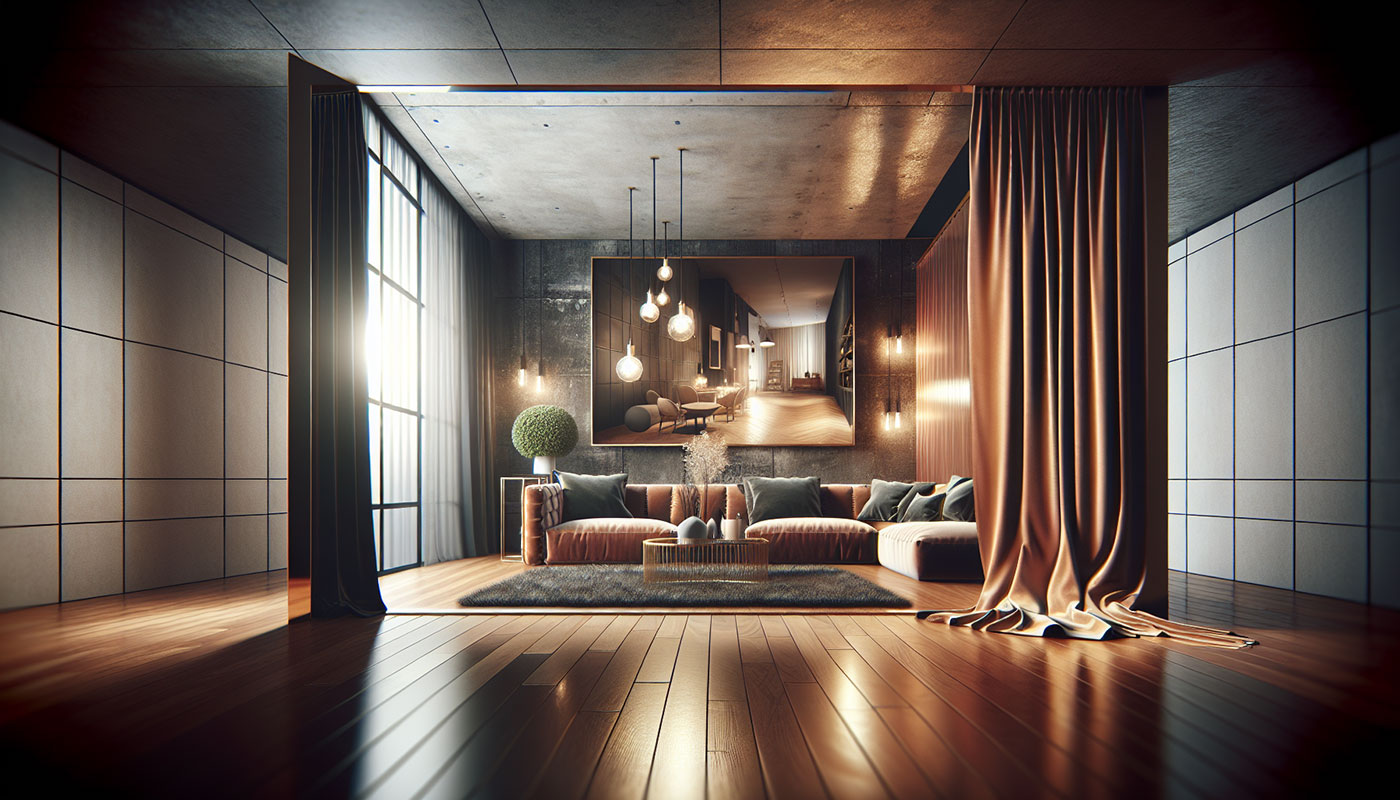Transform Your Space: Top 3D for Interior Design Tools & Tips for 2024

3D agora
April 16th, 2024

How does 3D for interior design transform the way we envision living spaces? Cut through the complexity with our clear guide on the essential tools and tactics that bring your design ideas to life with stunning realism and efficiency.
Mastering 3D Interior Design: Essential Tools and Techniques
 Generated by SurferAI
Generated by SurferAI
Mastering 3D interior design is a complex task. It demands a profound knowledge of indispensable tools and techniques in the field, which we will cover in this discussion. Whether you’re a novice or a seasoned professional, there’s always something new to learn in this ever-evolving industry.
One of the initial steps involves grasping the significance of CAD software such as AutoCAD and Revit. These are instrumental in crafting accurate floor plans and intricate 3D models, thereby assisting designers to meet building regulations. SketchUp Pro is another vital tool in the designer’s arsenal, widely used by architects for creating user-friendly 3D models and visualizations to engage clients and win projects.
For a more intuitive experience, consider Foyr Neo, which offers:
An AI-driven interface
Auto-lighting feature
Quick cloud rendering
Rapid creation of photorealistic interior images
Create Floor Plans
Crafting a precise floor plan stands as an imperative step in any interior design project. It involves:
Selecting a specific area
Taking precise measurements
Drawing walls to scale
Incorporating architectural features
Accurately positioning essential furniture and appliances.
3D modeling techniques can aid in this process by enabling you to conceptualize and arrange flat surfaces, establishing the foundational shape and pattern for the floor plan. One excellent tool for this task is Space Designer 3D, an online application designed for architects and real estate agents. It allows the creation of 2D floor plans that can be visualized in a 3D context.
Visualize Your Dream Home
 Generated by SurferAI
Generated by SurferAI
Having crafted your floor plans, the next step is to actualize your dream home. 3D interior design tools can dramatically improve your capacity to visualize spaces, assisting in practical furniture arrangement and adaptable room planning, such as converting an office into a bedroom.
These tools are not just about aesthetics but can also lead to significant cost savings by eliminating the need for physical models and permitting the virtual exploration of design alternatives. For instance, 3D models are crucial in providing proportionate and realistic visualizations for interior design elements such as furniture, facilitating a true-to-life representation of the envisioned space.
A tool like the Pantone Shade Book can assist with color selection and matching, helping you achieve the desired ambiance and aesthetic in both low and high poly models.
Low Poly vs. High Poly Models
An important consideration in 3D interior design is the choice between low poly and high poly models. This choice hinges on the level of detail desired and the impact on the performance of the rendering software.
High-poly models are preferred for their detailed close-up views, whereas low-poly models serve better for long-distance shots, minimizing computational resource use. Low-poly models also offer the advantage of rapid production time, ideal for online platforms where expedited loading and reduced memory usage are essential.
Opting for low-polygon modeling facilitates the creation of realistic and high-quality appearances while also economizing on storage and expediting website load times. However, high-poly models shouldn’t be disregarded as they offer more detail and points of articulation, which render them especially flexible for manipulation in nuanced design situations.
Enhance Your Designs with a Wide Range of Assets
 Generated by SurferAI
Generated by SurferAI
With a solid grasp of the basics, the next step is to elevate your designs by utilizing a broad spectrum of assets. Consider the Design Connected platform, which provides a vast array of furniture and accessory models specifically for 3D interior design. Experimenting with high-quality textures and various lighting options is another recommended practice for successful 3D interior design projects.
However, assets have more to offer than what is immediately apparent. Let’s probe further.
Categories Listed
A wide variety of furniture assets in multiple styles is imperative to accommodate diverse design preferences. These assets include options for residential, commercial, and office spaces, allowing designers to specialize in different environments.
Lighting and fixture assets are also essential, as they demonstrate the interplay of light and shadow in interior spaces. Don’t forget about decorative items and art pieces, which can be used to personalize spaces and add character to designs. Materials such as:
fabrics
woods
metals
stones
are available to accurately represent real-world textures. Texture assets play a key role in giving surfaces a realistic look and feel, which is important for close-up views.
Lastly, assets are also available for specific design themes such as minimalist, industrial, or eclectic, providing options for nearly any design concept.
File Formats Explained
Comprehending file formats is a vital element of employing assets in 3D interior design. The OBJ file format, for instance, supports complex geometries and is capable of handling detailed graphical data with textures and UV mapping.
The FBX format, developed by Kaydara and maintained by Autodesk, is designed for compatibility across various 3D graphics programs. A newer file format gaining traction is USD, which could streamline workflows involving multiple applications.
Collaborate and Share Your Projects with Clients
3D interior design not only involves crafting beautiful spaces but also entails presenting your work to clients and working together to realize their visions. 3D interior design allows for the creation of detailed and realistic visualizations, which can significantly improve communication with clients. By using 3D modeling services, you can offer your clients a clearer perspective on complex designs, thereby strengthening the designer-client relationship.
However, sharing detailed project data between different software platforms can pose challenges that may require conversion or compatible tools.
Platforms for Collaboration
In today’s digital age, collaboration is frequently enabled by online platforms. 3D Repo, for instance, serves as a platform for managing BIM data, enabling professionals to maintain proper version control and collaboration on 3D model revisions.
There are also software solutions like Bluebeam Revu and Bluebeam Cloud that enhance collaboration in architecture and construction sectors by automating processes. Mobile applications such as AutoCAD 360 offer the convenience of viewing and sharing floor plan drawings on-site, enabling immediate collaboration and decision-making between team members.
Quickbase provides a no-code solution for project management, while platforms like 3D Agora facilitate direct communication between artists and clients.
Presenting Your Work
 Generated by SurferAI
Generated by SurferAI
Presenting your work to clients is an art in itself. Learning and applying photography techniques tailored to interior design can significantly enhance the way 3D interior designs are presented to clients.
Learn from the Pros: Tutorials, Inspiration, and More
To hone your 3D interior design skills further, it is beneficial to gain insights from the experts. There are plenty of resources available, from tutorials to design inspiration, that can help you take your work to the next level. In addition, joining a community of fellow designers can provide invaluable support and feedback.
Some resources to consider are:
Online tutorials and courses
Design blogs and websites
Design magazines and books
Social media platforms like Instagram and Pinterest
By utilizing these resources and connecting with other designers, you can continue to improve and grow as a 3D interior designer with access to valuable insights.
Video Tutorials
A plethora of online video tutorials are available, offering guidance on diverse aspects of 3D interior design. Created and offered by professionals in the field, these tutorials encompass a wide range of industry topics.
Platforms like CERAMIC 3D and Home Design 3D offer professional video tutorials specifically tailored to improving interior design skills.
Get Inspired
 Generated by SurferAI
Generated by SurferAI
Creativity is a vital facet of 3D interior design, and at times, a dose of inspiration is needed to ignite fresh ideas. There are dedicated resources available that provide design ideas and visual inspiration to foster creativity in 3D interior design.
Platforms like Pinterest provide a vast array of high-quality images that can serve as inspiration for various interior design styles, aiding in the visualization process. Design websites also offer a plethora of 3D interior design ideas and inspirations to stimulate creativity.
Join the Community
A dynamic community of 3D interior designers exists, and becoming a part of it can significantly enhance your career.
On 3D Agora, clients can find skilled artists for their 3D interior design needs, and artists can find work. The platform also serves as a hub for sharing knowledge and fostering a vibrant design community.
Boost Your Career with 3D Interior Design
Gaining expertise in 3D interior design can substantially elevate your career in the architecture and design arenas. Professionals with expertise in this area can create more compelling visualizations and simulations, enhancing their service offering.
The ability to deliver exceptional 3D interior design work can lead to securing a steady flow of projects and opportunities within the field.
Opportunities on 3D Agora
3D Agora caters to artists in architectural visualization by offering a range of opportunities, including free freelance projects and potential employment.
Artists can utilize 3D Agora to filter and select projects that align with their particular set of skills and experience in architectural visualization. The platform encourages timely and detailed project delivery, which helps artists build and maintain a positive reputation, crucial for securing future work.
Tips for Success
Advancing your career in 3D interior design also requires strategic planning and effective networking. One key strategy is to build a diverse portfolio showcasing a range of styles, spaces, and complexities, which can help you stand out among competitors. High-quality renderings and detailed project descriptions in your portfolio will attract more clients and employment offers.
Regular communication with clients about the progress of their projects builds trust and leads to recurring business. Networking, whether through industry events or platforms like 3D Agora, can also lead to new opportunities.
Summary
In conclusion, 3D interior design is a dynamic and exciting field that offers numerous opportunities for creativity and career growth. By mastering the essential tools and techniques, leveraging a wide range of assets, improving collaboration with clients, continuously learning from the pros, and strategically planning your career, you can take your 3D interior design skills to new heights. It’s time to embrace the potential of 3D interior design and transform your career.